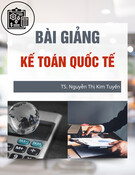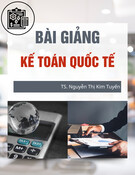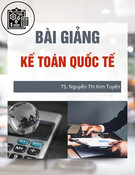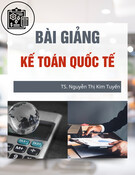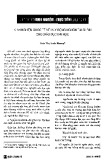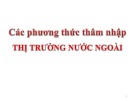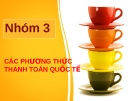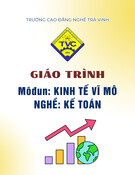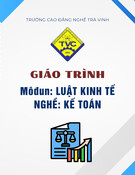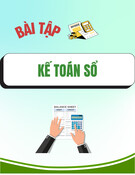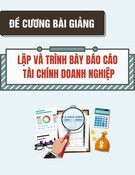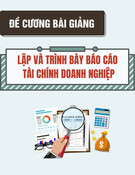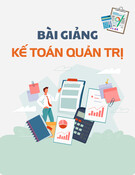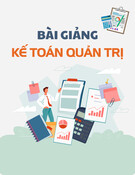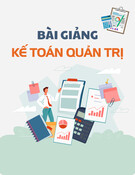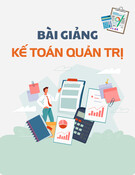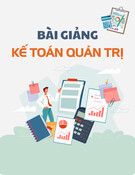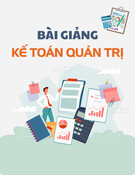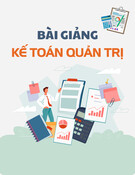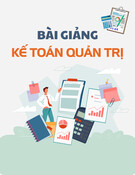IFA Chapter 8: Plant Assets and Intangible
Plant Assets and Intangible
LOGO
International Accounting of Financial
MA. Nguyen Quoc Nhat
Nguyen Quoc Nhat – nhatnq.faa@gmail.com Company Logo
Learning Objectives
Chapter’s content
8.1 Mesuring a the cost of a plant Asset 8.2 Depreciation 8.3 Displosing the plant Asset 8.4 Accounting for natural Resources 8.5 Accounting for Intangible Assets 8.6 Ethical Issue
Learning Objectives Measure the cost of a plant asset Account for depreciation Record the disposal of an asset by sale or trade Account for natural resources Account for intangible assets Describe ethical issues related to plant assets
Nguyen Quoc Nhat – nhatnq.faa@gmail.com
Company Logo
www.themegallery.com
Company Logo
8.1 Mesuring a the cost of a plant Asset
8.1 Mesuring a the cost of a plant Asset
The cost principle says to carry an asset at its historical cost—the amount paid for the asset. The rule for measuring cost is as follows: Cost of an asset = Sum of all the costs incurred to bring the asset to its intended purpose, net of all discounts
Land and land Improvements The cost of land is not depreciated. It includes the following costs paid by the purchaser: ● Purchase price ● Brokerage commission ● Survey and legal fees ● Property taxes in arrears ● Taxes assessed to transfer the ownership (title) on the land ● Cost of clearing the land and removing unwanted buildings
www.themegallery.com Company Logo www.themegallery.com Company Logo
MA.NguyenQuocNhat
1
IFA Chapter 8: Plant Assets and Intangible
8.1 Mesuring a the cost of a plant Asset
8.1 Mesuring a the cost of a plant Asset
The cost of land does not include the following costs: ● Fencing ● Paving ● Sprinkler systems ● Lighting ● Signs
Suppose Smart Touch needs property and purchases land for $50,000 with a note payable for the same amount. Smart Touch also pays cash as follows: $4,000 in property taxes in arrears, $2,000 in transfer taxes, $5,000 to remove an old building, and a $1,000 survey fee. What is the company’s cost of this land? This Exhibit shows all the costs incurred to bring the land to its intended use:
www.themegallery.com Company Logo www.themegallery.com Company Logo
8.1 Mesuring a the cost of a plant Asset
8.1 Mesuring a the cost of a plant Asset
Measuring the Cost of Land
The entry to record the purchase of the land on August 1, 2013, follows:
Purchase price of land
$50,000
2013
Add related costs
Aug 1
Land (A+)
62,000
Property taxes in arrears
$4,000
Transfer taxes
2,000
Note payable (L+)
50,000
Removal of building
5,000
Cash (A–)
12,000
Survey fee
1,000
12,000
Total cost of land
$62,000
www.themegallery.com
Company Logo
www.themegallery.com
Company Logo
8.1 Mesuring a the cost of a plant Asset
8.1 Mesuring a the cost of a plant Asset
Suppose Smart Touch then pays $20,000 for fences, paving, lighting, landscaping, and signs on August 15, 2013. The following entry records the cost of these land
2013
Aug 15 Land improvements (A+)
20,000
Cash (A–)
20,000
8.1.2 Buildings The cost of a building depends on whether the company is constructing the building itself or is buying an existing one. These costs include the following: Constructing a Building Architectural fees Building permits Contractor charges Payments for material, labor, and overhead Capitalized interest cost, if self-constructed
www.themegallery.com Company Logo www.themegallery.com Company Logo
MA.NguyenQuocNhat
2
IFA Chapter 8: Plant Assets and Intangible
8.1 Mesuring a the cost of a plant Asset
8.1 Mesuring a the cost of a plant Asset
8.1.3 Machinery and Equipment The cost of machinery and equipment includes
its
Purchasing an Existing Building Purchase price Costs to renovate the building to ready the building for use, which may include any of the charges listed under “Constructing a Building”
● purchase price (less any discounts), ● transportation charges, ● insurance while in transit, ● sales tax and other taxes, ● purchase commission, ● installation costs, and ● the cost of testing the asset before it is used.
www.themegallery.com Company Logo www.themegallery.com Company Logo
8.1 Mesuring a the cost of a plant Asset
8.1 Mesuring a the cost of a plant Asset
8.1.5 A Lump-Sum (Basket) Purchase of Assets
A company may pay a single price for several
assets as a group—a “basket purchase.” For example, Smart Touch may pay a single price for land and a building
For accounting, the company must identify the
8.1.4 Furniture and Fixtures Furniture and fixtures include desks, chairs, file cabinets, display racks, shelving, and so forth. The cost of furniture and fixtures includes the basic cost of each asset (less any discounts), plus all other costs to ready the asset for its intended use.
cost of each asset, as shown in the following diagram. The total cost paid (100%) is divided among the assets according to their relative sales or market values This is called the relative-salesvalue method.
www.themegallery.com
Company Logo
www.themegallery.com
Company Logo
8.1 Mesuring a the cost of a plant Asset
8.1 Mesuring a the cost of a plant Asset
8.1.5 A Lump-Sum (Basket) Purchase of Assets
The land makes up 25% of the total market
value, and the building 75%, as follows:
Asset
Percentage of Total
Total
Cost of
Market
(Sales)
Value
Purchase
Each
Value
X Price
Asset
Land
$30,000
$30,000/120,000 =
$100,000
= $25,000
25%
Building
90,000
$90,000/120,000 =
100,000
75,000
8.1.5 A Lump-Sum (Basket) Purchase of Assets Suppose Smart Touch paid a combined purchase price of $100,000 on August 1, 2013, for the land and building An appraisal performed a month before the purchase indicates that the land’s market (sales) value is $30,000 and the building’s market (sales) value is $90,000; But how will Smart Touch allocate the $100,000 paid for both assets
75%
Total
120,000
100%
$100,000
www.themegallery.com Company Logo www.themegallery.com Company Logo
MA.NguyenQuocNhat
3
IFA Chapter 8: Plant Assets and Intangible
8.1 Mesuring a the cost of a plant Asset
8.1 Mesuring a the cost of a plant Asset
8.1.5 A Lump-Sum (Basket) Purchase of Assets
8.1.6 Capital Expenditures Accountants divide spending made on plant
Suppose Smart Touch paid by signing
assets into two categories:
a note payable. The entry to record the purchase of the land and building is as follows:
● Capital expenditures ● Expenses Capital expenditures are debited to an asset
account because they
2013
Aug 1
Land (A+)
25,000
● increase the asset’s capacity or efficiency, or ● extend the asset’s useful life.
Building (A+)
75,000
Notes payable (L+)
100,000
www.themegallery.com Company Logo www.themegallery.com Company Logo
8.2 DEPRECIATION
8.2 DEPRECIATION
8.2.1 Causes of Depreciation 8.2.2 Measuring Depreciation 8.2.3 Depreciation Methods
8.2.1 Causes of Depreciation All assets, except land, wear out as they are used. Greg’s delivery truck can only go so many miles before it is worn out. As the truck is driven, this use is part of what causes depreciation Additionally, physical factors, like age and weather, can cause depreciation of assets.
www.themegallery.com
Company Logo
www.themegallery.com
Company Logo
8.2 DEPRECIATION
8.2 DEPRECIATION
8.2.2 Measuring Depreciation Depreciation of a plant asset is based on three
8.2.1 Causes of Depreciation Now that we have discussed causes of depreciation, let’s itemize what depreciation is not Depreciation is not a process of valuation.
Businesses do not record depreciation based on changes in the asset’s market (sales) value. Depreciation is recapturing the cost invested in the asset.
2. Depreciation does not mean that the business
sets aside cash to replace an asset when it is used up. Depreciation has nothing to do with cash.
main factors: Capitalized cost Estimated useful life Estimated residual value Estimated useful life is the length of the service period expected from the asset. The estimated useful life is how long the company expects it can use the asset. Useful life may be expressed in years, units, output, or miles
www.themegallery.com Company Logo www.themegallery.com Company Logo
MA.NguyenQuocNhat
4
IFA Chapter 8: Plant Assets and Intangible
8.2 DEPRECIATION
8.2 DEPRECIATION
8.2.2 Measuring Depreciation Estimated residual value also called
salvage value—is the asset’s expected cash value at the end of its useful life. A delivery truck’s useful life may be 100,000 miles. When the truck has been driven that distance, the company will sell or scrap it
8.2.3 Depreciation Methods There are many depreciation methods for plant assets, but three are used most commonly: ● Straight-line ● Units-of-production ● Declining-balance
www.themegallery.com Company Logo www.themegallery.com Company Logo
8.2 DEPRECIATION
8.2 DEPRECIATION
8.2.3 Depreciation Methods
These methods work differently in how
8.2.3 Depreciation Methods Straight-Line Method The straight-line (SL) method allocates an equal amount of depreciation to each year The equation for SL depreciation, applied to
they derive the yearly depreciation amount, but they all result in the same total depreciation over the total life of the asset. we will use the following data of Greg’s Tunes
the Greg’s Tunes’ truck, is as follows:
Data Item
Amount
Straight-line depreciation = (Cost – Residual
Cost of truck
$41,000
value)÷ life
Estimated residual value
(1,000)
Depreciable cost
$40,000
= (41,000 – 1,000) ÷ 5 = $8,000 per year
Estimated useful life—Years
5 years
Estimated useful life—Units
100,000 mi.
www.themegallery.com
Company Logo
www.themegallery.com
Company Logo
8.2 DEPRECIATION
8.2 DEPRECIATION
8.2.3 Depreciation Methods Units-of-Production (UOP) Method
8.2.3 Depreciation Methods Straight-Line Method Since the asset was placed in service on the
The units-of-production (UOP) method
first day of the year, the entry to record each year’s depreciation is as follows:
Dec 31
Depreciation expense—truck (E+)
8,000
allocates a fixed amount of depreciation to each unit of output. UOP depreciates by units rather than by years. A unit of output can be miles, units, hours, or output, depending on which unit type best defines the asset’s use.
Accumulated
depreciation—truck
8,000
(CA+)
www.themegallery.com Company Logo www.themegallery.com Company Logo
MA.NguyenQuocNhat
5
IFA Chapter 8: Plant Assets and Intangible
8.2 DEPRECIATION
8.2 DEPRECIATION
8.2.3 Depreciation Methods Units-of-production Depreciation Per unit of output = (Cost – Residual value) ÷
life in units
= (41,000 – 1,000) ÷ 100,000 = $0.4 per mile
8.2.3 Depreciation Methods Units-of-production Double-Declining-Balance Method An accelerated depreciation method writes off more depreciation near the start of an asset’s life than straight-line does. The main accelerated method of depreciation is the double-declining- balance (DDB) method DDB amounts can be computed using the following formula:
www.themegallery.com Company Logo www.themegallery.com Company Logo
8.2 DEPRECIATION
8.2 DEPRECIATION
8.2.3 Depreciation Methods Double-Declining-Balance Method (DDB) amounts can be computed using the following formula: Double-declining balance depreciation = (Cost – Accumulated depreciation) × 2 ÷ life For the first year of the truck, the calculation
8.2.3 Depreciation Methods Double-Declining-Balance Method (DDB) amounts can be computed using the following formula: Double-declining balance depreciation = (Cost – Accumulated depreciation) × 2 ÷ life For the first year of the truck, the calculation
would be as shown:
would be as shown:
DDB, year 1 = (41,000 – 0) × 2 ÷ 5 = $16,400
DDB, year 1 = (41,000 – 0) × 2 ÷ 5 = $16,400 DDB, year 2 = (41,000 – 16,400) × 2 ÷ 5 = $9,840
www.themegallery.com
Company Logo
www.themegallery.com
Company Logo
8.2 DEPRECIATION
8.2 DEPRECIATION
8.2.3 Other Issues in Accounting for Plant Assets Changing the Useful Life of a Depreciable Asset Asset Impairments Using Fully Depreciated Assets
8.2.3 Depreciation Methods Double-Declining-Balance Method (DDB) amounts can be computed using the following formula: Double-declining balance depreciation = (Cost – Accumulated depreciation) × 2 ÷ life For the first year of the truck, the calculation
would be as shown:
DDB, year 1 = (41,000 – 0) × 2 ÷ 5 = $16,400 DDB, year 2 = (41,000 – 16,400) × 2 ÷ 5 = $9,840
www.themegallery.com Company Logo www.themegallery.com Company Logo
MA.NguyenQuocNhat
6
IFA Chapter 8: Plant Assets and Intangible
8.2 DEPRECIATION
8.3 DISPOSING OF A PLANT ASSET
Eventually, an asset wears out or becomes obsolete. The owner then has two choices:
8.2.3 Other Issues in Accounting for Plant Assets Changing the Useful Life of a Depreciable Asset Asset Impairments Using Fully Depreciated Assets
Trade the asset for non-like property. This choice includes selling or scrapping the asset, or trading for an asset that is not similar in functionality
Trade the asset for another asset that has
similar functionality. This is called a nonmonetary or like-kind exchange
www.themegallery.com Company Logo www.themegallery.com Company Logo
8.4 ACCOUNTING FOR INTANGIBLE ASSETS
8.4 ACCOUNTING FOR INTANGIBLE ASSETS
Specific Intangibles
As we saw earlier, intangible assets have no physical form. Instead, these assets convey special rights from patents, copyrights, trademarks, and other creative works.
In our technology-driven economy, intangibles are very important. The intellectual capital of Microsoft or Intel is difficult to measure.
Accounting for their purchase and their decline in value for each is the same. We will illustrate the accounting by using a patent. Patents Suppose Greg’s Tunes pays $200,000 to acquire a patent on January 1, 2011. Greg’s Tunes believes this patent’s useful life is only five years because it is likely that a new, more efficient process will be developed within that time. Amortization expense is therefore $40,000 per year ($200,000/5 years).
www.themegallery.com
Company Logo
www.themegallery.com
Company Logo
8.4 ACCOUNTING FOR INTANGIBLE ASSETS
8.4 ACCOUNTING FOR INTANGIBLE ASSETS
Specific Intangibles Copyrights
Specific Intangibles Acquisition and amortization entries for this patent are as follows:
2011
Jan 1
Patents (A+)
200,000
200,000
Cash (A–)
To acquire a patent.
A copyright is the exclusive right to reproduce and sell a book, musical composition, film, or other work of art or intellectual property Trademarks and Brand Names Trademarks and brand names (also known as
Dec 31 Amortization expense—patents
40,000
($200,000/5) (E+)
trade names) are assets that represent distinctive products or services, such as the Nike “swoosh” or the NASCAR number
Patents (A–)
40,000
3 for Dale Earnhardt
To amortize the cost of a patent
www.themegallery.com Company Logo www.themegallery.com Company Logo
MA.NguyenQuocNhat
7
IFA Chapter 8: Plant Assets and Intangible
8.4 ACCOUNTING FOR INTANGIBLE ASSETS
8.4 ACCOUNTING FOR INTANGIBLE ASSETS
Specific Intangibles (Cont) Franchises and Licenses
Specific Intangibles (Cont) Copyrights
Franchises and licenses are privileges granted by
A copyright is the exclusive right to
reproduce and sell a book, musical composition, film, or other work of art or intellectual property Trademarks and Brand Names Trademarks and brand names (also known as
a private business or a government to sell goods or services under specified conditions Goodwill Goodwill in accounting has a different meaning from the everyday phrase “goodwill among men.” In accounting, goodwill is the excess of the cost to purchase another company over the market value of its net assets (assets minus liabilities).
trade names) are assets that represent distinctive products or services, such as the Nike “swoosh” or the NASCAR number
www.themegallery.com Company Logo www.themegallery.com Company Logo
3 for Dale Earnhardt
LOGO
www.themegallery.com

